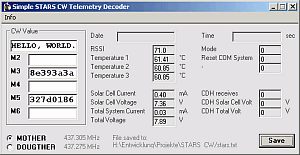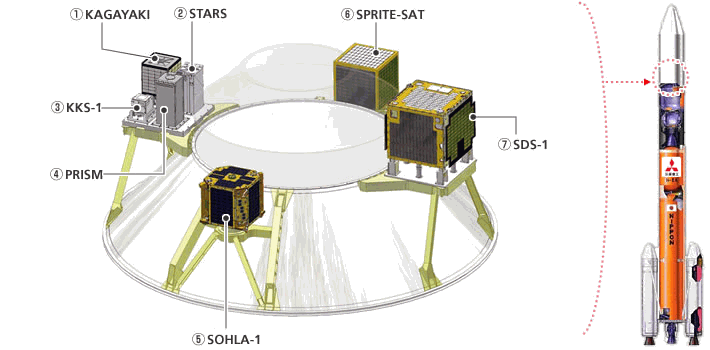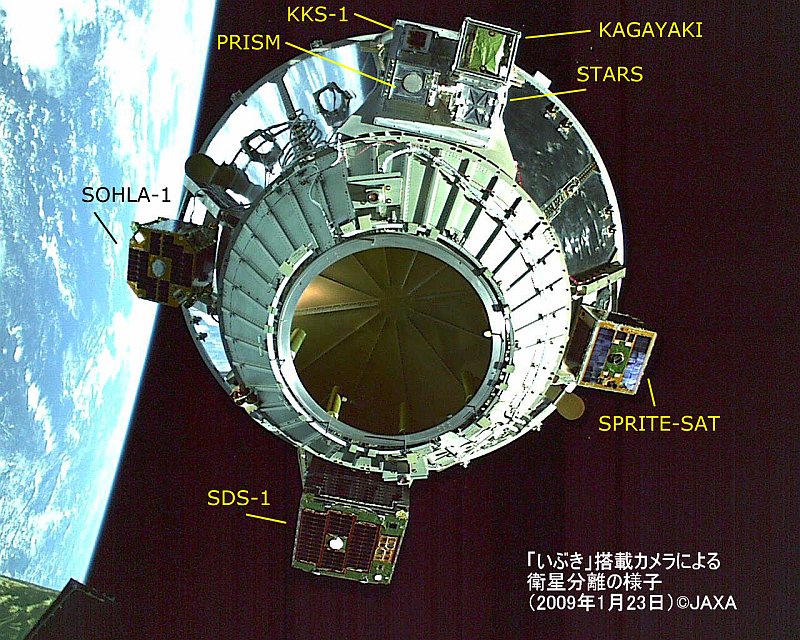STARS-II
Space Tethered Autonomous Robotic Satellite, Kagawa University

STARS-2 is a follow-on mission of STARS-1 which was launched on January 23, 2009 on the H-IIA vehicle from the Tanegashima Space Center, Kagoshima, Japan. STARS-1 was a secondary payload of the GOSAT mission. The satellite was launched on Thursday, 27 Feb at 1807 UTC from the Yoshinobu Launch Complex at the Tanegashima Space Center.
Mother Satellite
NASA-Catalog: tbd
Downlink
437.405 MHz FM 1k2 AFSK
Bake
437.245 MHz CW
Call
JR5YDX
Status
ACTIVE
Orbital Parameter
NORAD tbd COSPAR designator 2014-000-A Inclination 65.000 RA of A. Node 54.000 Eccentricity 0.0011000 Argument of Perigee 354.200 Revs per day 15.59133824 Period 1h 32m 21s (92.35 min) Semi-major axis 6 768 km Perigee x Apogee 383 x 398 km BStar (drag term) 0.000260300 1/ER Mean anomaly 227.600
Daughter Satellite
NASA-Catalog: tbd
Downlink
437.425 MHz FM 1k2 AFSK
Bake
437.255 MHz CW
Call
JR5YDY
Status
active

STARS-I
Space Tethered Autonomous Robotic Satellite, Kagawa University
Am 23.01.2009 um 03:54 UTC startete eine H-IIA F15 Rakete vom Tanegashima Space Center in Japan. Hauptnutzulast war GOSAT (Ibuki), der weltweit erste Satellit, der den Klimawandel untersuchen soll. Als Piggiback Payload waren noch 6 weitere Satelliten an Bord. Um 04:27 UTC wurde STARS separiert.

Mother Satellite KU
NASA-Catalog: 33498
Downlink
437.485 MHz FM 1k2 AFSK
Bake
437.305 CW
Call
JR5YBN
Status
CW Bake aktiv
Orbital Parameter
NORAD #33498 COSPAR Bezeichnung 2009-002-G Inklination (Grad) 98.029 RAAN 138.727 Excentrizität 0.0013976 ARGP 59.221 Umläufe pro Tag 14.71265062 Periode 1h 37m 52s (97.87 Min) Semi-major axis 7 035 km Perigäum x Apogäum 647 x 667 km Bstar (drag Faktor) 0.000054783 1/ER Mean Anomaly 301.037
erste empfangene Telemetrie
12:05 UTC STARS (M) 437.305 MHz CW sounds noisy hello, world. m3 95 40 3c 3e m5 ff ff 94 ff hello, world. 15:20 UTC STARS (M) 437.305 MHz m5 ff ff ff ff hello, world. m3 70 44 42 3f m5 ff ff ff ff hello, world.
Daughter Satellite KAI
NASA-Catalog: 33498
Downlink
437.465 FM 1k2 AFSK
Bake
437.2725 MHz CW
Call
JR5YBO
Status
CW Bake aktiv
erste empfangene Telemetrie
12:03 UTC STARS (D) 437.275 MHz m5 1d 73 02 6f hello, world. m3 76 3a 3a 39 m5 1d 75 01 93 hello, world. m3 83 39 3a 3a m5 28 ac 00 6d hello, world.
STARS CW Telemetry Decoder

Der empfangene String (jeweils 8 Zeichen) für die Werte M2 bis M6 wird in das entsprechende Textfeld eingegeben und die berechneten Telemetriewerte werden übersichtlich angezeigt. Die Daten können in einem ASCII File abgespeichert werden. Zur besseren Unterscheidung im ASCII FIle kann man die Option MOTHER/DOUGHTER wählen. Bei der Berechnung gibt es allerdings keine Unterschiede, es handelt sich lediglich um ein Textfeld.

Download Version 1.2 [27.01.2009]
Mission
This aims to conduct a tether space robot technology demonstration. A verification of tether extension by parent and child satellites will also be carried out.
STARS consists of Mother Satellite and Daughter Satellite connected by tether. Mother Satellite deploys tether having Daughter Satellite at its end. Daughter Satellite has one arm, and tether is attached at its end. Then attitude control by arm motion using tether tension is possible. Main mission is to take pictures of a satellite during tether deployment. For the purpose of the mission:
1. Mother Satellite deploys tether having Daughter Satellite at its end
2. Daughter Satellite controls attitude of CCD camera by robot motion
3. Mother Satellite and Daughter Satellite communicate through Bluetooth.
Daughter Satellite takes a picture of Mother Satellite, and it is transmitted to ground stations through amateur radio frequency. It will be much interested to take a picture of satellite in space.


Telemetrie

Links und weitere Informationen
http://stars1.eng.kagawa-u.ac.jp/english/index.htmlhttp://www.jaxa.jp/countdown/f15/overview/sub_payload_e.html